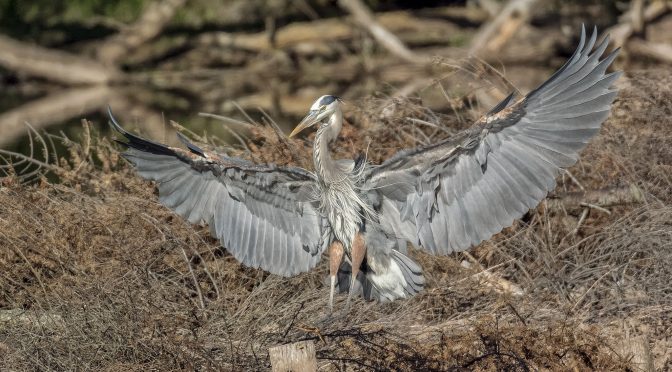In some previous articles the importance of getting to know specific environments and observing bird behaviour has been discussed. This short article continues that content thread by sharing some images of a post hopping heron.
NOTE: Click on images to enlarge.

Birds tend to be creatures of habit and they regularly return to specific areas to feed. This is certainly the case at the Hendrie Valley Sanctuary where Great Blue Herons regularly fish from the burms that separate Lake Ontario from the Grindstone Creek.

The herons often change their position by 3 to 5 metres (~10 to 16 feet) by taking very short flights that only last for a wing beat or two. These short ‘air hops’ provide photographers with good opportunities to capture images of the herons with their wings in beautiful extended positions.

One of the most common things that the herons do is to move from one post in the water to the next. This snippet of action is signaled by the birds with a slight head bob and leg flex. By anticipating the ‘post hop’ and keeping your camera focused on the heron it is possible to capture these moments.

The key is to use a continuous auto-focus (AF-C) setting and shoot with a fast frame rate. The action is over very quickly so timing your shots is important. As soon as you see the heron’s head bob and leg flex, start firing your AF-C burst. When framing your photographs be sure to allow room for the heron’s wingspan. The resulting captures should be similar to the images shown in this article.
Below is a 5-frame AF-C image series captured at the end of a ‘post hop’. You’ll notice that the focal length has changed in the EXIF data as the heron was getting closer to me with each of its ‘post hops’. You’ll also notice that the ISO changed in the last 2 frames as I was shooting in Manual using an Auto-ISO setting.





This is only one example of how observing birds and anticipating their behaviour can help you capture photographs of them in action.
Technical Note:
All photographs were captured hand-held using Nikon 1 gear as per the EXIF data. All images were produced from RAW files using my standard process of DxO PhotoLab, CS6, and the Nik Collection.
Word of mouth is the best form of advertising. If you like our website please let your friends and associates know about our work. Linking to this site or to specific articles is allowed with proper acknowledgement. Reproducing articles or any of the images contained in them on another website is a Copyright infringement.
My intent is to keep this photography blog advertising free. If you enjoyed this article and/or my website and would like to support my work you can purchase an eBook, or make a modest $10 donation through PayPal, both are most appreciated. You can use the Donate button below. Larger donations can be made to tom@tomstirr.com through PayPal.
Article and all images are Copyright 2018 Thomas Stirr. All rights reserved. No use, duplication or adaptation of any kind is allowed without written consent. If you see this article reproduced anywhere else it is an unauthorized and illegal use. Posting comments on offending web sites and calling out individuals who steal intellectual property is always appreciated!


Well captured series. That is the combo I use a lot.
Thanks Vern – glad you enjoyed the images!